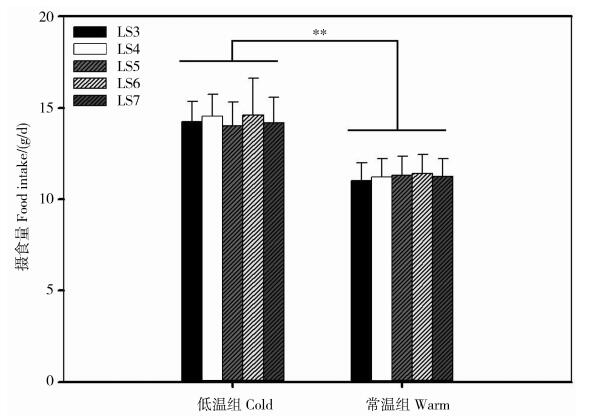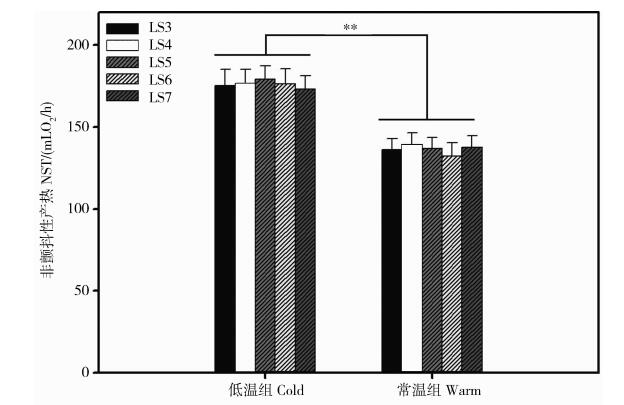扩展功能
文章信息
- 朱万龙, 刘军, 蔡金红
- ZHU Wanlong, LIU Jun, CAI Jinhong
- 温度和增加胎仔数对大绒鼠哺乳期能量代谢的影响
- Effects of Temperature and Raising Litter Size on Energy Metabolism during Lactation in Eothenomys miletus
- 四川动物, 2016, 35(5): 691-696
- Sichuan Journal of Zoology, 2016, 35(5): 691-696
- 10.11984/j.issn.1000-7083.20160131
-
文章历史
- 收稿日期: 2016-05-20
- 接受日期: 2016-07-05
2. 2. 连云港师范高等专科学校, 江苏连云港 222006
2. Lianyungang Normal College, Lianyungang, Jiangsu Province 222006, China
哺乳期是动物能量需求最大的一个时期,而能量摄入在哺乳期往往被限制(Speakman & Krol,2011)。许多研究表明动物哺乳期最大持续能量摄入(sustained energy intake,SusEI)受到不同因素的限制(Johnson et al., 2001;Bacigalupe & Bozinovic,2002;Krol & Speakman,2003)。目前,关于SusEI的限制主要有3种假说:中央限制假说(central limitation hypothesis)认为中心供能器官是主要制约因子,这些器官为所有耗能器官获取、处理和分配能量(Hammond & Diamond,1994);外周限制假说(peripheral limitation hypothesis)认为动物的能量收支极限与动物个体本身有关,与动物的能量消耗方式相联系,外周器官对能量的实际消耗能力制约着动物的持续能量收支(Speakman,2008);热散失假说(heat dissipation limitation hypothesis)认为哺乳期动物的SusEI受动物散热能力的限制(Krol & Speakman,2003)。已有研究表明动物的SusEI不受消化道消化能力的限制,即不支持中央限制假说,而支持外周限制假说(Hammond & Diamond,1994)或热散失假说(Speakman & Krol,2011)。如低温可以增加MF1小鼠Mus musculus的乳腺泌乳能力,而暖温条件则会降低乳腺泌乳能力(Speakman & Krol,2005)。背部剃毛的MF1小鼠较对照组食物摄入量增加,从而增加乳汁分泌(Krol et al., 2007),这些研究结果支持热散失假说。而与MF1小鼠不同,背部剃毛对黑线仓鼠Cricetulus barabensis的乳汁分泌和胎仔质量没有影响,支持外周限制假说(Zhao & Cao,2009;Zhao et al., 2010)。动物哺乳期的SusEI到底是支持外周限制假说还是热散失假说,取决于动物是受到外周器官的泌乳能力的限制还是散热能力的限制,即到底是泌乳能力强还是热散失能力强。对于MF1小鼠而言,泌乳能力要强于热散失能力,而黑线仓鼠的泌乳能力则弱于热散失能力。
大绒鼠Eothenomys miletus为横断山区固有种,中国特有种,主要分布于横断山及其附近地区。已有研究表明哺乳期大绒鼠会增加能量摄入和支出(Zhu & Wang,2014),幼仔在胎后发育过程中会增加其产热能力(Zhu et al., 2015)。背部剃毛大绒鼠的SusEI受到乳腺泌乳能力的限制,即支持外周限制假说。既然SusEI的限制取决于动物的泌乳能力和散热能力,为了深入研究大绒鼠哺乳期SusEI的限制到底支持哪种假说,本文在已有研究的基础上,设计了温度和多胎仔数对大绒鼠哺乳期SusEI的影响,将哺乳期大绒鼠置于常温(25 ℃)和低温(5 ℃)环境下,研究大绒鼠热散失能力的大小,而在大绒鼠正常胎仔数的情况下增加胎仔数,研究其泌乳能力的大小,以期阐明大绒鼠哺乳期SusEI的限制所支持假说。
1 材料与方法 1.1 动物来源实验用大绒鼠为人工饲养种群,饲养于透明塑料鼠盒内(长260 mm×宽160 mm×高150 mm),无巢材,每盒1只;每日喂以浸泡过的玉米,用塑料瓶供水。
1.2 动物处理挑选3~4月龄的成年雌性大绒鼠(n=159),与雄性配对14 d,14 d后移出雄性。其中113只雌性怀孕,分娩后第7天将大绒鼠的胎仔数进行人工分组。大绒鼠正常胎仔数为2只,本研究在此基础上增加胎仔数,分为胎仔数3、4、5、6、7只5个组,所有大绒鼠在25 ℃±1 ℃,光照12L:12D的环境下驯化。哺乳第10天,每组选取一半大绒鼠置于5 ℃±1 ℃,光照12L:12D的环境下驯化。所有大绒鼠在第22天断奶,哺乳第10~22天每天记录胎仔数和胎仔质量。
1.3 代谢率的测定第22天在室内测定静止代谢率(resting metabolic rate,RMR),实验前大绒鼠在呼吸室内静置30 min左右,进入呼吸室后适应30 min,开放式呼吸仪(AD Instruments,ML870,澳大利亚)在热中性区测定RMR,SPX-300型人工气候箱(上海博讯医疗设备厂)控制温度。呼吸室为500 mL,进入呼吸室的气体流量为200 mL·min-1,实验温度控制在(25±0.5) ℃,实验进行1.5 h,前0.5 h使大绒鼠适应呼吸室环境,之后记录1 h,每隔1 min记录1次,选取10个连续稳定的最低值计算RMR(Zhu et al., 2008)。测定RMR后,皮下注射去甲肾上腺素(norepinephrine,NE)测定大绒鼠在25 ℃下的最大非颤抖性产热(nonshivering thermogenesis,NST)。NE注射剂量经预实验确定为0.8 mg/kgBW,将注射NE后30 min内出现的最大耗氧量视为大绒鼠的NST。
1.4 摄食量的测定从第10天开始至第22天结束,每天测定大绒鼠的摄食量,定时定量喂食(实验前一天的11:00—13:00,食物19.5~20.5 g),次日小心收集剩余食物(每次收集时间均为11:00—13:00)。收集的食物在烘箱中干燥至恒重(Zhu et al., 2010)。由于胎仔数超过正常哺育胎仔数,大绒鼠摄食量在第10~22天的差异无统计学意义,因此摄食量数据在分析时合并。
1.5 乳腺质量的测定第22天,将大绒鼠处死,分离出乳腺组织,在烘箱中干燥至恒重。
1.6 统计分析采用SPSS 13.0处理数据。摄食量、胎仔数、平均胎仔质量和胎仔质量均采用双因素方差分析(Two-Way ANOVA)。RMR、NST和乳腺质量的差异采用双因素协方差分析(Two-Way ACNOVA),以体质量或胴体质量作为协变量。结果均以平均值±标准误表示(Mean±SE),P<0.05为差异有统计学意义,P<0.01为差异有高度统计学意义。
2 结果 2.1 摄食量温度对哺乳期大绒鼠摄食量影响的差异有高度统计学意义(F=9.35,P<0.01),低温组的摄食量显著高于常温组(图 1)。而胎仔数对大绒鼠摄食量没有影响(F=0.87,P>0.05,图 1)。

|
| 图 1 温度对增加胎仔数大绒鼠哺乳期摄食量的影响 Fig. 1 Effect of temperature on food intake during lactation in Eothenomys miletus raising more litters **差异有高度统计学意义, LS.胎仔数; 下同。 **Extremely significant difference, LS. litter size; the same below. |
| |
第10~11天,温度对哺乳期大绒鼠的胎仔数影响的差异无统计学意义(P>0.05),第13~22天,温度对胎仔数影响的差异有高度统计学意义(P<0.01)。低温驯化条件下,大绒鼠胎仔数显著减少,差异有高度统计学意义(P<0.01),胎仔数较多的组别较同时期常温条件下的减少更多(表 1)。
| 哺乳天数 Day of lactation/d |
低温组Cold | 常温组Warm | P | |||||||||
| LS=3 | LS=4 | LS=5 | LS=6 | LS=7 | LS=3 | LS=4 | LS=5 | LS=6 | LS=7 | |||
| 10 | 2.8±0.2 | 3.9±0.3 | 4.8±0.4 | 5.6±0.4 | 6.6±0.7 | 2.9±0.2 | 3.9±0.4 | 4.7±0.4 | 5.5±0.4 | 6.4±0.5 | T.ns, LS.** | |
| 11 | 2.7±0.2 | 3.8±0.4 | 4.5±0.5 | 5.3±0.5 | 6.2±0.8 | 2.9±0.2 | 3.9±0.4 | 4.7±0.4 | 5.3±0.4 | 6.3±0.4 | T.ns, LS.** | |
| 12 | 2.6±0.2 | 3.8±0.3 | 4.3±0.4 | 5.0±0.6 | 5.5±0.4 | 2.9±0.2 | 3.9±0.4 | 4.6±0.3 | 5.2±0.3 | 6.3±0.4 | T.*, LS.** | |
| 13 | 2.4±0.2 | 3.7±0.3 | 4.2±0.4 | 4.8±0.4 | 5.1±0.4 | 2.9±0.2 | 3.8±0.3 | 4.6±0.3 | 5.2±0.3 | 6.3±0.4 | T.**, LS.** | |
| 14 | 2.4±0.2 | 3.6±0.2 | 4.1±0.4 | 4.5±0.4 | 5.0±0.3 | 2.9±0.2 | 3.8±0.3 | 4.5±0.3 | 5.1±0.2 | 6.0±0.3 | T.**, LS.** | |
| 15 | 2.4±0.2 | 3.5±0.3 | 4.0±0.3 | 4.1±0.5 | 4.8±0.4 | 2.9±0.2 | 3.7±0.4 | 4.5±0.3 | 5.1±0.2 | 6.0±0.3 | T.**, LS.** | |
| 16 | 2.4±0.2 | 3.4±0.4 | 3.8±0.4 | 3.9±0.4 | 4.5±0.4 | 2.9±0.2 | 3.7±0.4 | 4.5±0.3 | 5.1±0.2 | 6.0±0.3 | T.**, LS.** | |
| 17 | 2.4±0.2 | 3.2±0.4 | 3.6±0.4 | 3.7±0.4 | 4.2±0.3 | 2.8±0.2 | 3.5±0.2 | 4.5±0.3 | 5.1±0.2 | 5.8±0.4 | T.**, LS.** | |
| 18 | 2.4±0.2 | 3.2±0.3 | 3.4±0.3 | 3.3±0.5 | 3.9±0.3 | 2.8±0.2 | 3.5±0.2 | 4.5±0.3 | 5.1±0.2 | 5.8±0.4 | T.**, LS.** | |
| 19 | 2.4±0.2 | 3.2±0.3 | 3.2±0.4 | 3.0±0.4 | 3.6±0.4 | 2.8±0.2 | 3.1±0.2 | 4.5±0.3 | 5.1±0.2 | 5.8±0.4 | T.**, LS.** | |
| 20 | 2.3±0.2 | 3.1±0.2 | 2.9±0.4 | 2.9±0.5 | 3.3±0.5 | 2.8±0.2 | 3.1±0.2 | 4.5±0.3 | 5.1±0.2 | 5.8±0.4 | T.**, LS.** | |
| 21 | 2.3±0.2 | 2.9±0.2 | 2.8±0.4 | 2.8±0.4 | 3.0±0.6 | 2.8±0.2 | 3.1±0.2 | 4.5±0.3 | 5.1±0.2 | 5.8±0.4 | T.**, LS.** | |
| 22 | 2.3±0.2 | 2.7±0.2 | 2.7±0.3 | 2.6±0.4 | 2.8±0.5 | 2.8±0.2 | 3.1±0.2 | 4.3±0.3 | 5.1±0.2 | 5.8±0.4 | T.**, LS.** | |
| 注:T.温度,LS.胎仔数;*P<0.05,* *P<0.01,ns.无统计学意义;下表同。 Notes: T. temperature, LS. litter size; *P<0.05, * *P<0.01, ns. no significant difference; the same below. | ||||||||||||
第12~17天,温度对大绒鼠的总胎仔质量影响的差异有高度统计学意义(P<0.01)。第18~22天,温度对大绒鼠的总胎仔质量影响的差异无统计学意义(P>0.05)。同一哺乳天数内相同胎仔数组的总胎仔质量为低温组低于常温组,并在第12天后极显著低于常温组(P<0.01)(表 2)。大绒鼠的平均胎仔质量随时间的延长而增加,且程度随胎仔数的增加而变缓。同一哺乳天数相同胎仔数常温驯化条件下的平均胎仔质量增加幅度较低温驯化条件下的大(表 3)。
| 哺乳天数 Day of lactation/d |
低温组Cold | 常温组Warm | P | |||||||||
| LS=3 | LS=4 | LS=5 | LS=6 | LS=7 | LS=3 | LS=4 | LS=5 | LS=6 | LS=7 | |||
| 10 | 14.1±1.1 | 18.5±1.3 | 21.3±1.6 | 24.8±2.2 | 27.7±2.2 | 16.4±2.3 | 20.3±2.2 | 22.6±2.5 | 25.4±2.2 | 28.7±2.3 | T.ns, LS.** | |
| 11 | 14.3±1.2 | 18.6±1.6 | 21.2±1.5 | 23.9±1.9 | 26.7±2.1 | 17.0±2.3 | 20.3±2.1 | 23.1±2.6 | 25.9±2.3 | 29.3±2.3 | T.ns, LS.** | |
| 12 | 14.1±0.9 | 19.1±1.3 | 21.2±1.9 | 23.5±1.5 | 24.3±2.3 | 17.8±2.1 | 21.5±2.2 | 23.6±2.3 | 26.3±2.3 | 29.7±2.6 | T.**, LS.** | |
| 13 | 13.9±1.5 | 20.0±1.5 | 21.8±1.9 | 23.8±1.6 | 23.0±2.2 | 18.7±1.6 | 22.0±1.9 | 24.5±2.3 | 27.4±2.5 | 29.4±2.5 | T.**, LS.** | |
| 14 | 14.4±1.3 | 20.2±1.2 | 21.7±2.0 | 23.5±1.8 | 23.4±1.9 | 19.9±1.8 | 22.8±1.8 | 30.1±2.4 | 28.1±2.6 | 30.7±2.1 | T.**, LS.** | |
| 15 | 14.8±1.2 | 20.1±1.1 | 22.0±1.5 | 21.8±1.5 | 23.5±1.8 | 20.9±1.9 | 22.4±1.6 | 31.2±2.2 | 29.7±2.5 | 31.3±2.2 | T.**, LS.** | |
| 16 | 15.3±1.3 | 20.1±1.3 | 22.1±1.6 | 21.0±1.6 | 23.1±1.6 | 21.2±2.1 | 23.2±2.2 | 32.3±2.6 | 31.2±2.3 | 31.3±2.2 | T.**, LS.** | |
| 17 | 15.9±1.1 | 19.7±1.6 | 21.0±1.5 | 20.4±1.9 | 22.0±1.6 | 21.8±2.2 | 23.2±2.0 | 34.0±2.8 | 32.7±3.1 | 31.4±2.3 | T.**, LS.** | |
| 18 | 16.9±1.2 | 20.4±1.2 | 20.4±1.6 | 18.9±1.3 | 20.9±2.4 | 22.7±2.3 | 24.3±2.0 | 35.6±2.7 | 33.2±3.2 | 33.1±2.8 | T.**, LS. ns | |
| 19 | 17.7±1.3 | 21.1±1.8 | 19.7±1.3 | 17.4±2.0 | 20.0±2.1 | 23.6±2.5 | 23.8±2.1 | 37.3±2.5 | 34.7±3.3 | 34.9±2.9 | T.**, LS. ns | |
| 20 | 18.5±1.2 | 21.2±1.3 | 18.3±1.5 | 17.4±1.6 | 18.5±2.3 | 23.6±2.3 | 24.8±2.3 | 39.5±2.6 | 34.7±3.3 | 35.4±2.7 | T.**, LS. ns | |
| 21 | 18.6±1.3 | 20.5±1.5 | 18.2±1.8 | 17.4±1.9 | 17.5±2.2 | 24.2±2.6 | 25.5±2.2 | 40.7±3.2 | 35.3±3.6 | 36.0±3.3 | T.**, LS. ns | |
| 22 | 19.1±1.4 | 19.8±2.1 | 18.4±1.7 | 16.5±1.8 | 16.5±2.2 | 24.5±2.4 | 26.8±2.1 | 32.4±3.3 | 36.3±3.8 | 37.2±3.5 | T.**, LS. ns | |
| 哺乳天数 Day of lactation/d |
低温组Cold | 常温组Warm | P | |||||||||
| LS=3 | LS=4 | LS=5 | LS=6 | LS=7 | LS=3 | LS=4 | LS=5 | LS=6 | LS=7 | |||
| 10 | 5.1±0.4 | 4.8±0.4 | 4.5±0.4 | 4.4±0.4 | 4.2±0.4 | 5.5±0.4 | 5.1±0.3 | 4.8±0.4 | 4.6±0.3 | 4.5±0.3 | T.ns, LS.** | |
| 11 | 5.2±0.4 | 4.9±0.3 | 4.7±0.5 | 4.5±0.5 | 4.3±0.4 | 5.7±0.5 | 5.2±0.3 | 4.9±0.3 | 4.7±0.2 | 4.6±0.3 | T.ns, LS.** | |
| 12 | 5.4±0.5 | 5.1±0.3 | 4.9±0.5 | 4.7±0.4 | 4.4±0.5 | 6.0±0.3 | 5.5±0.4 | 5.1±0.5 | 4.9±0.3 | 4.7±0.3 | T.*, LS.** | |
| 13 | 5.7±0.4 | 5.4±0.4 | 5.2±0.6 | 4.9±0.4 | 4.5±0.6 | 6.3±0.3 | 5.7±0.4 | 5.3±0.3 | 5.1±0.3 | 4.9±0.2 | T.*, LS.** | |
| 14 | 5.9±0.5 | 5.6±0.3 | 5.3±0.4 | 5.2±0.4 | 4.7±0.5 | 6.7±0.4 | 5.9±0.3 | 5.4±0.4 | 5.4±0.4 | 5.1±0.5 | T.**, LS.** | |
| 15 | 6.1±0.4 | 5.7±0.2 | 5.5±0.4 | 5.3±0.3 | 4.9±0.4 | 7.1±0.4 | 6.0±0.5 | 5.6±0.3 | 5.7±0.3 | 5.2±0.4 | T.**, LS.** | |
| 16 | 6.3±0.4 | 5.9±0.3 | 5.8±0.3 | 5.4±0.2 | 5.1±0.4 | 7.2±0.6 | 6.2±0.3 | 5.8±0.3 | 6.1±0.4 | 5.2±0.3 | T.**, LS.** | |
| 17 | 6.6±0.3 | 6.1±0.4 | 5.9±0.3 | 5.6±0.4 | 5.2±0.3 | 7.5±0.5 | 6.6±0.3 | 6.1±0.3 | 6.4±0.5 | 5.4±0.3 | T.**, LS.** | |
| 18 | 7.0±0.4 | 6.4±0.3 | 6.0±0.3 | 5.7±0.3 | 5.4±0.3 | 7.8±0.5 | 6.9±0.4 | 6.4±0.4 | 6.5±0.3 | 5.7±0.3 | T.**, LS.** | |
| 19 | 7.4±0.4 | 6.7±0.3 | 6.2±0.4 | 5.8±0.3 | 5.5±0.3 | 8.1±0.4 | 7.2±0.5 | 6.7±0.4 | 6.8±0.4 | 6.0±0.4 | T.**, LS.** | |
| 20 | 7.8±0.3 | 6.9±0.4 | 6.3±0.3 | 6.0±0.4 | 5.6±0.4 | 8.2±0.4 | 7.5±0.3 | 7.1±0.3 | 6.8±0.3 | 6.1±0.2 | T.**, LS.** | |
| 21 | 7.9±0.3 | 7.1±0.5 | 6.6±0.4 | 6.2±0.4 | 5.8±0.3 | 8.4±0.5 | 7.7±0.3 | 7.3±0.4 | 6.9±0.4 | 6.2±0.3 | T.**, LS.** | |
| 22 | 8.2±0.4 | 7.4±0.3 | 6.8±0.4 | 6.3±0.3 | 5.9±0.4 | 8.5±0.4 | 8.1±0.4 | 7.5±0.3 | 7.1±0.4 | 6.4±0.3 | T.**, LS.** | |
第10~22天,温度对RMR的影响有高度统计学意义(P<0.01),低温组显著高于常温组(图 2)。NST的变化趋势与RMR相似,表现为低温组极显著高于常温组(P<0.01)(图 3)。低温驯化条件下胎仔数3、4、5、6、7只组的乳腺质量分别为1.33 g±0.11 g、1.42 g±0.16 g、1.39 g±0.12 g、1.44 g±0.19 g、1.46 g±0.21 g,常温驯化条件下胎仔数3、4、5、6、7只组的乳腺质量分别为1.68 g±0.13 g、1.54 g±0.11 g、1.68 g±0.21 g、1.65 g±0.19 g、1.71 g±0.23 g,差异无统计学意义(P>0.05)。

|
| 图 2 温度对增加胎仔数大绒鼠哺乳期静止代谢率的影响 Fig. 2 Effect of temperature on resting metabolic rate (RMR) during lactation in Eothenomys miletus raising more litters |
| |

|
| 图 3 温度对增加胎仔数大绒鼠哺乳期非颤抖性产热的影响 Fig. 3 Effect of temperature on nonshivering thermogenesis (NST) during lactation in Eothenomys miletus raising more litters |
| |
外周限制假说认为哺乳期动物SusEI受乳腺泌乳能力的限制(Hammond & Diamond,1997)。而热散失假说认为哺乳期动物SusEI受散热能力的限制(Speakman & Krol,2005)。本研究结果表明,低温可以增加大绒鼠的摄食量,能量摄入的增加符合外周限制假说和热散失假说的预测。外周限制假说认为低温条件下增加能量摄入是为了维持动物的体温平衡,而热散失假说认为低温条件下增加能量摄入是弥补低温条件下动物产热能力的增加(Hammond et al., 1996)。2种假说的不同点在于热散失假说认为低温可以提高乳腺的泌乳能力,而外周限制假说认为在低温条件下乳腺的泌乳能力已经达到最大,不会再增加(Zhao,2012)。
大绒鼠的平均胎仔质量随着哺乳期的延长而增加,和摄食量的变化趋势一致,说明不管是在低温还是常温驯化条件下大绒鼠通过增加食物摄入来增加乳汁分泌,最终来增加幼仔的体质量。温度对总胎仔质量和乳腺质量没有影响,说明哺乳期大绒鼠乳腺的泌乳能力已经达到最大,支持外周限制假说。此外,低温组的总胎仔质量较常温组的小,原因可能有2个:一是低温驯化条件下大绒鼠乳腺的泌乳能力受到限制,导致胎仔质量较小;二是低温驯化条件下大绒鼠的产热能力增加,用于哺育后代的能量减少,因此后代的胎仔质量较小。本研究结果还表明低温可以刺激大绒鼠的RMR和NST增加,但是对乳腺质量没有影响,说明大绒鼠哺乳期SusEI受乳腺泌乳能力的限制。
综上所述,增加胎仔数对大绒鼠的摄食量、胎仔质量和产热能力没有影响。低温可以刺激大绒鼠摄食量和产热能力的增加,断奶后低温组的胎仔质量显著低于常温组。乳腺质量不受温度影响。这表明大绒鼠哺乳期SusEI的上限可能受到乳腺泌乳能力的限制,支持外周限制假说。
| Bacigalupe LD, Bozinovic F. 2002. Design, limitations and sustained metabolic rate: lessons from small mammals[J]. Journal of Experimental Biology , 205(19) : 2963–2970. |
| Hammond KA, Diamond J. 1994. Limits to dietary nutrient intake and intestinal nutrient uptake in lactating mice[J]. Physiological Zoology , 67(1) : 282–303. DOI:10.1086/physzool.67.1.30163847 |
| Hammond KA, Lloyd KCK, Diamond J. 1996. Is mammary output capacity limiting to lactational performance in mice?[J]. Journal of Experimental Biology , 199(2) : 337–349. |
| Hammond KA, Diamond J. 1997. Maximum sustained energy budgets in humans and animals[J]. Nature , 386(6624) : 457–462. DOI:10.1038/386457a0 |
| Johnson MS, Thomson SC, Speakman JR. 2001. Limits to sustained energy intake. I. Lactation in the laboratory mouse Mus musculus[J]. Journal of Experimental Biology , 204(11) : 1925–1935. |
| Krol E, Speakman JR. 2003. Limits to sustained energy intake. Ⅵ. Energetics of lactation in laboratory mice at thermoneutrality[J]. Journal of Experimental Biology , 206(23) : 4255–4266. DOI:10.1242/jeb.00674 |
| Krol E, Murphy M, Speakman JR. 2007. Limits to sustained energy intake. X. Effects of fur removal on reproductive performance in laboratory mice[J]. Journal of Experimental Biology , 210(23) : 4233–4243. DOI:10.1242/jeb.009779 |
| Speakman JR, Krol E. 2005. Limits to sustained energy intake IX: a review of hypotheses[J]. Journal of Comparative Physiology , 175(175) : 375–394. |
| Speakman JR, Krol E. 2011. Limits to sustained energy intake. XIII. Recent progress and future perspectives[J]. Journal of Experimental Biology , 214(2) : 230–241. DOI:10.1242/jeb.048603 |
| Speakman JR. 2008. The physiological cost of reproduction in small mammals[J]. Philosophical Transactions of the Royal Society of London , 363(1490) : 375–398. DOI:10.1098/rstb.2007.2145 |
| Zhao ZJ, Cao J. 2009. Effect of fur removal on the thermal conductance and energy budget in lactating Swiss mice[J]. Journal of Experimental Biology , 212(16) : 2541–2549. DOI:10.1242/jeb.029603 |
| Zhao ZJ, Chi QS, Cao J. 2010. Milk energy output during peak lactation in shaved Swiss mice[J]. Physiology & Behavior , 101(1) : 59–66. |
| Zhao ZJ. 2012. Effect of cold exposure on energy budget and thermogenesis during lactation in Swiss mice raising large litters[J]. Biology Open , 2(1) : 394–404. |
| Zhu WL, Jia T, Lian X, et al. 2008. Evaporative water loss and energy metabolic in two small mammals, voles (Eothenomys miletus) and mice (Apodemus chevrieri) in Hengduan Mountains region[J]. Journal of Thermal Biology , 33(6) : 324–331. DOI:10.1016/j.jtherbio.2008.04.002 |
| Zhu WL, Cai JH, Lian X, et al. 2010. Adaptive character of metabolism in Eothenomys miletus in Hengduan Mountains region during cold acclimation[J]. Journal of Thermal Biology , 35(8) : 417–421. DOI:10.1016/j.jtherbio.2010.09.002 |
| Zhu WL, Wang ZK. 2014. Resting metabolic rate and energetics of reproduction in lactating Eothenomys miletus from Hengduan Mountain region[J]. Zoological Studies , 53(1) : 41. DOI:10.1186/s40555-014-0041-3 |
| Zhu WL, Zhang H, Meng LH, et al. 2015. Variations in enzyme activity of brown adipose tissue and liver during postnatal development energy requirements during lactation in Eothenomys miletus (Mammalia: Rodentia: Cricetidae)[J]. Journal of Zoological and Bioscience Research , 2(2) : 9–16. |
 2016, Vol. 35
2016, Vol. 35




